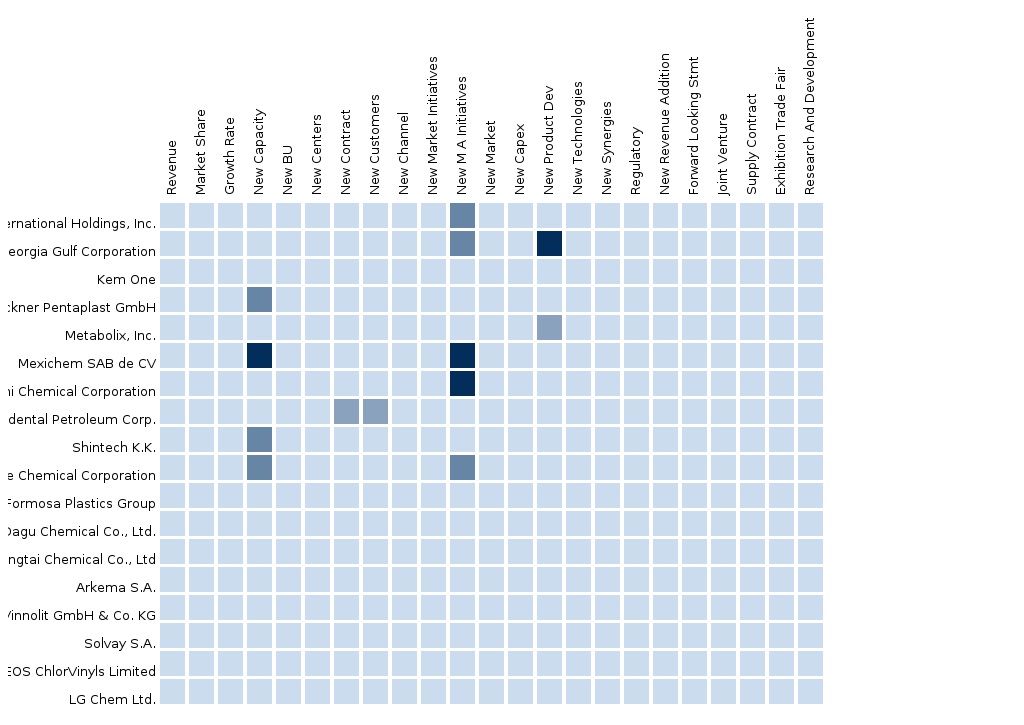The Europe Polyvinyl Chloride Market is witnessing a high growth due to the increasing demand in the building & construction industry. The report estimates the size of the European Polyvinyl Chloride Market, both in terms of volume and value. The report provides a comprehensive overview of the key market drivers, challenges and issues. The European Polyvinyl Chloride Market is projected to reach $10,571.24 million by 2019, at a CAGR of 4.7% from 2014 to 2019. The key driver of the market is the increasing use of plastics in various industry verticals especially in the automotive production.
The report “Europe Polyvinyl Chloride Market” defines and segments the polyvinyl chloride market in the region with analyses and projections of the size of the Polyvinyl Chloride Market with respect to volume (KT) and value ($Million).
Polyvinyl Chloride (PVC) is one of the most widely used plastics in the world. It is produced by polymerizing vinyl chloride monomers. Various properties of PVC such as abrasion resistance, light weight, good mechanical strength, and toughness enable its wide use in building & construction, automotive, packaging, and electrical industries.
The Europe Polyvinyl Chloride Market is segmented on the basis of types of applications such as rigid polyvinyl chloride and flexible polyvinyl chloride. The Europe Polyvinyl Chloride Market report also studies the end user industry such as construction, packaging, electrical, automotive, footwear, and others.
The report covers Europe Polyvinyl Chloride Market and its trends concerning with the key countries such as Germany, Italy, Turkey and Russia.
Further, as part of qualitative analysis, this report provides a comprehensive review of important drivers, restraints, opportunities, and key issues in the Europe Polyvinyl Chloride Market.
The report also provides an extensive competitive landscape of the companies operating in this market. It also includes the company profiles and competitive strategies adopted by various market players such as INEOS (U.K.), Solvay S.A. (Belgium), Kem One (France), Vinnolit GmbH & Co. KG (Germany) and other players in the Europe Polyvinyl Chloride Market.
Customization Options:
Along with the market data, you can also customize MMM assessments that meet your company’s specific needs. Customize to get comprehensive industry standards and deep dive analysis of the following parameters:
- Production Data at country level with much comprehended approach of understanding
- Comprehensive coverage of plant capacity estimates that will analyze the future prospects of the market
- Plant Capacities for major countries (by companies)
- Analysis of Load factor to understand actual production at country level
- Trade data - Import-export data, by each country within the region and other key countries of the world
- Backward chain integration to understand the approach of business prevailing in the market
- A country-wise split of volume and value of PVC market can be provided by product type such as pipes & fittings, profiles & tubes, film & sheets, wire & cables, bottles and others; type of application such as rigid polyvinyl chloride and flexible polyvinyl chloride; polymerization process such as Suspension Polymerization, Emulsion Polymerization, Microsuspension Polymerization, Mass Polymerization and by raw material N-ethylcarbodiimide hydrochloride (EDC) and acetylene
1 Introduction
1.1 Objective of the study
1.2 Market Definitions
1.3 Market Segmentation & Aspects Covered
1.4 Research Methodology
1.4.1 Assumptions (Market Size, Forecast, etc)
2 Executive Summary
3 Market Overview
4 Polyvinyl Chloride-Europe, by Applications
4.1 Split by Geography
4.1 Polyvinyl Chloride-Germany by Applications
4.1 Polyvinyl Chloride-Italy by Applications
4.1 Polyvinyl Chloride-Europe - Russia by Applications
4.1 Polyvinyl Chloride-Europe - Turkey by Applications
4.2 Polyvinyl Chloride-Europe-Building & Construction
4.2.1 Polyvinyl Chloride-Europe-Building & Construction, by Geographies
4.2.1.1 Polyvinyl Chloride-Germany-Building & Construction
4.2.1.2 Polyvinyl Chloride-Italy-Building & Construction
4.2.1.3 Polyvinyl Chloride-Europe - Russia-Building & Construction
4.2.1.4 Polyvinyl Chloride-Europe - Turkey-Building & Construction
4.3 Polyvinyl Chloride-Europe-Packaging
4.3.1 Polyvinyl Chloride-Europe-Packaging, by Geographies
4.3.1.1 Polyvinyl Chloride-Germany-Packaging
4.3.1.2 Polyvinyl Chloride-Italy-Packaging
4.3.1.3 Polyvinyl Chloride-Europe - Russia-Packaging
4.3.1.4 Polyvinyl Chloride-Europe - Turkey-Packaging
4.4 Polyvinyl Chloride-Europe-Automotive Plastics
4.4.1 Polyvinyl Chloride-Europe-Automotive Plastics, by Geographies
4.4.1.1 Polyvinyl Chloride-Germany-Automotive Plastics
4.4.1.2 Polyvinyl Chloride-Italy-Automotive Plastics
4.4.1.3 Polyvinyl Chloride-Europe - Russia-Automotive Plastics
4.4.1.4 Polyvinyl Chloride-Europe - Turkey-Automotive Plastics
4.5 Polyvinyl Chloride-Europe-Electrical & Electronics
4.5.1 Polyvinyl Chloride-Europe-Electrical & Electronics, by Geographies
4.5.1.1 Polyvinyl Chloride-Germany-Electrical & Electronics
4.5.1.2 Polyvinyl Chloride-Italy-Electrical & Electronics
4.5.1.3 Polyvinyl Chloride-Europe - Russia-Electrical & Electronics
4.5.1.4 Polyvinyl Chloride-Europe - Turkey-Electrical & Electronics
4.6 Polyvinyl Chloride-Europe-Footwear
4.6.1 Polyvinyl Chloride-Europe-Footwear, by Geographies
4.6.1.1 Polyvinyl Chloride-Germany-Footwear
4.6.1.2 Polyvinyl Chloride-Italy-Footwear
4.6.1.3 Polyvinyl Chloride-Europe - Russia-Footwear
4.6.1.4 Polyvinyl Chloride-Europe - Turkey-Footwear
5 Polyvinyl Chloride-Europe, by Geographies
5.1 Polyvinyl Chloride-Germany
5.1.1 Polyvinyl Chloride-Germany, by Applications
5.1.1.1 Polyvinyl Chloride-Germany-Building & Construction
5.1.1.2 Polyvinyl Chloride-Germany-Packaging
5.1.1.3 Polyvinyl Chloride-Germany-Automotive Plastics
5.1.1.4 Polyvinyl Chloride-Germany-Electrical & Electronics
5.1.1.5 Polyvinyl Chloride-Germany-Footwear
5.2 Polyvinyl Chloride-Italy
5.2.1 Polyvinyl Chloride-Italy, by Applications
5.2.1.1 Polyvinyl Chloride-Italy-Building & Construction
5.2.1.2 Polyvinyl Chloride-Italy-Packaging
5.2.1.3 Polyvinyl Chloride-Italy-Automotive Plastics
5.2.1.4 Polyvinyl Chloride-Italy-Electrical & Electronics
5.2.1.5 Polyvinyl Chloride-Italy-Footwear
5.3 Polyvinyl Chloride-Europe - Russia
5.3.1 Polyvinyl Chloride-Europe - Russia, by Applications
5.3.1.1 Polyvinyl Chloride-Europe - Russia-Building & Construction
5.3.1.2 Polyvinyl Chloride-Europe - Russia-Packaging
5.3.1.3 Polyvinyl Chloride-Europe - Russia-Automotive Plastics
5.3.1.4 Polyvinyl Chloride-Europe - Russia-Electrical & Electronics
5.3.1.5 Polyvinyl Chloride-Europe - Russia-Footwear
5.4 Polyvinyl Chloride-Europe - Turkey
5.4.1 Polyvinyl Chloride-Europe - Turkey, by Applications
5.4.1.1 Polyvinyl Chloride-Europe - Turkey-Building & Construction
5.4.1.2 Polyvinyl Chloride-Europe - Turkey-Packaging
5.4.1.3 Polyvinyl Chloride-Europe - Turkey-Electrical & Electronics
5.4.1.4 Polyvinyl Chloride-Europe - Turkey-Footwear
5.4.1.5 Polyvinyl Chloride-Europe - Turkey-Automotive Plastics
6 Polyvinyl Chloride-Europe, by Companies
6.1 Competitive landscape
6.2 Split by Geography
6.2 Polyvinyl Chloride-Germany by Companies
6.1 Polyvinyl Chloride-Italy by Companies
6.1 Polyvinyl Chloride-Europe - Russia by Companies
6.1 Polyvinyl Chloride-Europe - Turkey by Companies
6.3 Polyvinyl Chloride-Europe-INEOS ChlorVinyls Limited
6.4 Polyvinyl Chloride-Europe-Solvay S.A.
6.5 Polyvinyl Chloride-Europe-Vinnolit GmbH & Co. KG
6.6 Polyvinyl Chloride-Europe-Arkema S.A.

Please fill in the form below to receive a free copy of the Summary of this Report
Please visit http://www.micromarketmonitor.com/custom-research-services.html to specify your custom Research Requirement














